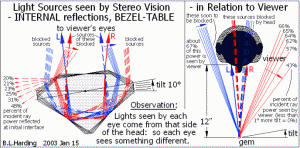- Joined
- Aug 15, 2000
- Messages
- 19,109
For the record – the ideal stone is 1.06ct H VS2 and has a 55.3% table, 34.9° crown and 40.75° pavilion with virtually no painting or digging. The shallow stone is 59.5% table, 31.3° crown and 40.6° pavilion with some creative digging on 2 sides to remove some naturals. The Gem Adviser file for the ideal stone is attached and I am happy to send the full DiamCalc and Helium scan data to anyone by email.
You may need to download the free Gem Adviser software if you dont have it already - it is amazing that such a tool can be made free - so f you dont have it - please get it - you can find the links under tools> DiamCalc in the upper right of this page.
You may need to download the free Gem Adviser software if you dont have it already - it is amazing that such a tool can be made free - so f you dont have it - please get it - you can find the links under tools> DiamCalc in the upper right of this page.


























300x240.png)